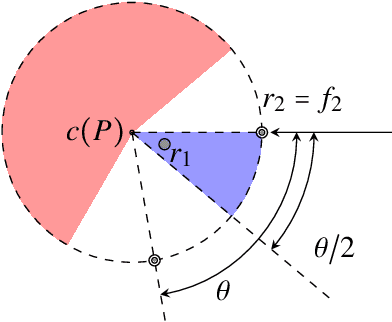Quentin Bramas
NPA, LIP6, UPMC, LINCS
Infinite Grid Exploration by Disoriented Robots
Jun 07, 2019



Abstract:We deal with a set of autonomous robots moving on an infinite grid. Those robots are opaque, have limited visibility capabilities, and run using synchronous Look-Compute-Move cycles. They all agree on a common chirality, but have no global compass. Finally, they may use lights of different colors, but except from that, robots have neither persistent memories, nor communication mean. We consider the infinite grid exploration (IGE) problem. For this problem we give two impossibility results and three algorithms, including one which is optimal in terms of number of robots. In more detail, we first show that two robots are not sufficient in our settings to solve the problem, even when robots have a common coordinate system. We then show that if the robots' coordinate systems are not self-consistent, three or four robots are not sufficient to solve the problem. Finally, we present three algorithms that solve the IGE problem in various settings. The first algorithm uses six robots with constant colors and a visibility range of one. The second one uses the minimum number of robots, i.e., five, as well as five modifiable colors, still under visibility one. The last algorithm requires seven oblivious anonymous robots, yet assuming visibility two. Notice that the two last algorithms also satisfy achieve exclusiveness.
Probabilistic Asynchronous Arbitrary Pattern Formation
Sep 20, 2017



Abstract:We propose a new probabilistic pattern formation algorithm for oblivious mobile robots that operates inthe ASYNC model. Unlike previous work, our algorithm makes no assumptions about the local coordinatesystems of robots (the robots do not share a common "North" nor a common "Right"), yet it preserves theability from any initial configuration that contains at least 5 robots to form any general pattern (and not justpatterns that satisfy symmetricity predicates). Our proposal also gets rid of the previous assumption (in thesame model) that robots do not pause while moving (so, our robots really are fully asynchronous), and theamount of randomness is kept low -- a single random bit per robot per Look-Compute-Move cycle is used.Our protocol consists in the combination of two phases, a probabilistic leader election phase, and a deterministicpattern formation one. As the deterministic phase does not use chirality, it may be of independentinterest in the deterministic context. A noteworthy feature of our algorithm is the ability to form patternswith multiplicity points (except the gathering case due to impossibility results), a new feature in the contextof pattern formation that we believe is an important asset of our approach.
The Random Bit Complexity of Mobile Robots Scattering
Feb 24, 2015Abstract:We consider the problem of scattering $n$ robots in a two dimensional continuous space. As this problem is impossible to solve in a deterministic manner, all solutions must be probabilistic. We investigate the amount of randomness (that is, the number of random bits used by the robots) that is required to achieve scattering. We first prove that $n \log n$ random bits are necessary to scatter $n$ robots in any setting. Also, we give a sufficient condition for a scattering algorithm to be random bit optimal. As it turns out that previous solutions for scattering satisfy our condition, they are hence proved random bit optimal for the scattering problem. Then, we investigate the time complexity of scattering when strong multiplicity detection is not available. We prove that such algorithms cannot converge in constant time in the general case and in $o(\log \log n)$ rounds for random bits optimal scattering algorithms. However, we present a family of scattering algorithms that converge as fast as needed without using multiplicity detection. Also, we put forward a specific protocol of this family that is random bit optimal ($n \log n$ random bits are used) and time optimal ($\log \log n$ rounds are used). This improves the time complexity of previous results in the same setting by a $\log n$ factor. Aside from characterizing the random bit complexity of mobile robot scattering, our study also closes its time complexity gap with and without strong multiplicity detection (that is, $O(1)$ time complexity is only achievable when strong multiplicity detection is available, and it is possible to approach it as needed otherwise).
 Add to Chrome
Add to Chrome Add to Firefox
Add to Firefox Add to Edge
Add to Edge